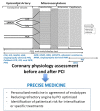Coronary Physiology: Delivering Precision Medicine?
- PMID: 39077613
- PMCID: PMC11273948
- DOI: 10.31083/j.rcm2305158
Coronary Physiology: Delivering Precision Medicine?
Abstract
Coronary physiological assessment is now widely used to assess epicardial coronary lesions in cath lab. Based on clinical evidence, fractional flow reserve (FFR) is the gold standard method to select whether epicardial coronary lesions need revascularization. While additional epicardial indexes, such as instantaneous wave-free ratio (iFR), are also used for revascularization decision-making, several indexes are now also available to explore the coronary microcirculation. Therefore, coronary physiological assessment now allows to explore the entire coronary tree and offer the potential of precision medicine for patients affected by coronary artery disease (CAD). This paper will provide review of the epicardial and microvascular indexes available for the assessment of coronary physiology. More specifically, the already demonstrated contributions of these indexes in the management of CAD and the role they could play in precision medicine will be reviewed with special emphasis on chronic coronary syndrome.
Keywords: coronary microcirculation dysfunction; coronary physiology assessment; precise medicine.
Copyright: © 2022 The Author(s). Published by IMR Press.
Conflict of interest statement
Gilles Barone-Rochette has received research grants from Merck Sharp and Dohme, and consulting fees from Bayer, Abbott vascular, Novo Nordisk, Sanofi, and AMGEN. The others authors declare no conflict of interest.
Figures


References
-
- Tonino PAL, Fearon WF, De Bruyne B, Oldroyd KG, Leesar MA, Ver Lee PN, et al. Angiographic versus functional severity of coronary artery stenoses in the FAME study fractional flow reserve versus angiography in multivessel evaluation. Journal of the American College of Cardiology . 2010;55:2816–2821. - PubMed
-
- Camici PG, d’Amati G, Rimoldi O. Coronary microvascular dysfunction: mechanisms and functional assessment. Nature Reviews Cardiology . 2015;12:48–62. - PubMed
-
- Beltrame JF, Crea F, Kaski JC, Ogawa H, Ong P, Sechtem U, et al. International standardization of diagnostic criteria for vasospastic angina. European Heart Journal . 2017;38:2565–2568. - PubMed
-
- Kogame N, Ono M, Kawashima H, Tomaniak M, Hara H, Leipsic J, et al. The Impact of Coronary Physiology on Contemporary Clinical Decision Making. JACC: Cardiovascular Interventions . 2020;13:1617–1638. - PubMed
Publication types
LinkOut - more resources
Full Text Sources
Miscellaneous

